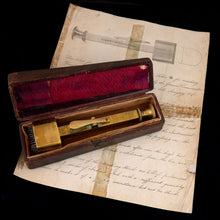A Military Deserter Marking Instrument, 1842
Adding product to your cart
Length: cm (5.7in)
Brass. Instrument for instantly tattooing or 'branding', deserters with a letter ‘D’. Inscribed with the maker’s name Savigny & Co., 67 St. James's Street, London. Contained in original morocco covered case and complete with original instructions for use.
The branding of miscreants in Britain has a long history. Until the late 18th century criminals convicted at the Old Bailey could be branded with ’T’ for thief, ‘F’ for felon and ‘M’ for murderer. The practice was discontinued for civilians in 1829 but persisted in armed forces until 1871. During the Napoleonic Wars a statute of 1807 decreed deserters were to be marked with a ‘D’ tattoo to the left side of the chest. In 1841 a medical officer suggested speeding up the ‘very painful’ process with the manufacture of a specially produced tool. In 1842 the Army introduced at the present instrument with spring-loaded mechanism and spiked D-shaped head to deliver the wound which was then rubbed over with a mixture of indigo, Indian ink and water to form the indelible ‘D’. Occasionally deserters tried to disguise their marks by as part of an elaborate tattoo design. Four soldiers transported to Australia in 1844 covered their deserter marks with a Union Jack tattoos. As tattoos could fade or be removed a log was introduced shortly before the Crimean War, in which medical officers could record their handiwork and condition of the tattoo. Of the estimated 1051 deserters transported to Van Diemen’s Land, 800 are recorded as marked.
For an identical example of this instrument see the Science Museum, London. Viz - ‘Brass instrument for 'branding', deserters with a letter 'D', in leather covered case, by Savigny and Co., 67 St. James's Street, London, England, 1810-1850. Branding tools stamped the letter ‘D’ on the skin of army or navy deserters. The adjustable points, which still bear ink traces of ink, were pushed through the skin by a sprung-powered mechanism. This unpleasant device was made by Savigny & Co, better known as a major London maker of surgical instruments in the 1700s and early 1800s.








